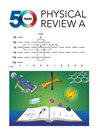准二维盒约束中的两个超冷原子
IF 2.9
2区 物理与天体物理
Q2 Physics and Astronomy
引用次数: 0
摘要
我们研究了两个超冷原子在准二维(quasi-2D)束缚中的散射和二体束缚态。束缚势在横向(z)方向上是一个无限深的方井(盒势),而原子在 x-y 平面上的运动是自由的。具体来说,我们计算了低能散射的有效二维散射长度和二维有效范围参数,以及束缚态的能量和横向激发模式概率。将这些结果与在谐波横向约束势(与盒式约束势具有相同的特征长度)下得到的结果进行比较,我们发现在大多数情况下,盒式约束的二维有效范围参数约为谐波约束的0.28。此外,盒约束的束缚态横向激发模式概率也比谐波约束的低得多。这些结果表明,在特征长度相同的情况下,盒约束的横向激发明显弱于谐波约束。因此,通过盒约束实现纯二维有效模型描述的准二维超冷气体,尤其是具有二维接触相互作用的超冷气体,更加可行。我们的结果有助于超冷原子的二维多体物理的量子模拟,例如,二维有效范围参数的抑制可能会导致二维费米气体中量子反常现象的增强。此外,我们的计算方法也适用于超冷原子在其他类型的准二维约束中的两体问题。本文章由计算机程序翻译,如有差异,请以英文原文为准。

Two ultracold atoms in a quasi-two-dimensional box confinement
We investigate the scattering and two-body bound states of two ultracold atoms in a quasi-two-dimensional (quasi-2D) confinement, with the confinement potential being an infinitely deep square well (box potential) in the transverse () direction, and the motion of the atoms in the plane being free. Specifically, we calculate the effective 2D scattering length and 2D effective range parameter of the low-energy scattering, as well as the energy and the transverse-excited-mode probability of the bound states. Comparing these results with those obtained under a harmonic transverse confinement potential, which has the same characteristic length as the box potential, we find that in most of the cases the 2D effective range parameter for the box confinement is approximately 0.28 of the one for the harmonic confinement. Moreover, the transverse-excited-mode probability of the bound states for the box confinement is also much lower than the one for the harmonic confinement. These results suggest that the transverse excitation in the box confinement is notably weaker than the one in the harmonic confinement with the same characteristic length. Therefore, achieving quasi-2D ultracold gases well described by pure-2D effective models, particularly those with 2D contact interaction, is more feasible through box confinement. Our results are helpful for the quantum simulation of 2D many-body physics with ultracold atoms, e.g., the suppression of 2D effective range parameter may lead to an enhancement of quantum anomaly in two-dimensional Fermi gases. Additionally, our calculation method is applicable to the two-body problems of ultracold atoms in other types of quasi-2D confinements.
求助全文
通过发布文献求助,成功后即可免费获取论文全文。
去求助
来源期刊

Physical Review A
物理-光学
CiteScore
5.40
自引率
24.10%
发文量
0
审稿时长
2.2 months
期刊介绍:
Physical Review A (PRA) publishes important developments in the rapidly evolving areas of atomic, molecular, and optical (AMO) physics, quantum information, and related fundamental concepts.
PRA covers atomic, molecular, and optical physics, foundations of quantum mechanics, and quantum information, including:
-Fundamental concepts
-Quantum information
-Atomic and molecular structure and dynamics; high-precision measurement
-Atomic and molecular collisions and interactions
-Atomic and molecular processes in external fields, including interactions with strong fields and short pulses
-Matter waves and collective properties of cold atoms and molecules
-Quantum optics, physics of lasers, nonlinear optics, and classical optics
 求助内容:
求助内容: 应助结果提醒方式:
应助结果提醒方式:


